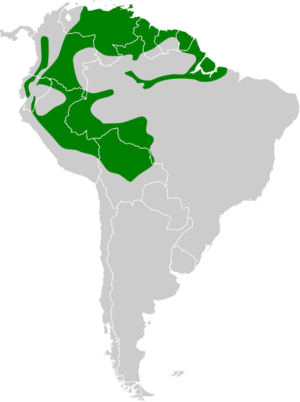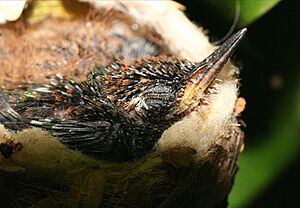Blue-tailed emerald facts for kids
The blue-tailed emerald (Chlorostilbon mellisugus) is a tiny, shiny hummingbird. It's known for its bright colors, especially its blue tail. You can find this beautiful bird in warm, sunny parts of South America, mainly east of the Andes mountains. It lives in countries like Colombia, Brazil, Trinidad, and the Guianas.
Quick facts for kids Blue-tailed emerald |
|
|---|---|
 |
|
| Conservation status | |
| Scientific classification | |
| Genus: |
Chlorostilbon
|
| Species: |
mellisugus
|
 |
|
| Synonyms | |
|
Trochilus mellisugus Linnaeus, 1758 |
|
Contents
How the Blue-tailed Emerald Got Its Name
The blue-tailed emerald was first officially described in 1758. This was done by a Swedish scientist named Carl Linnaeus. He gave it the scientific name Trochilus mellisugus.
The name mellisugus comes from Latin words. Mel means "honey" and sugere means "to suck". This name perfectly describes how hummingbirds drink nectar. Over time, scientists learned more about this bird. They moved it to a different group, or genus, called Chlorostilbon.
Different Kinds of Blue-tailed Emeralds
Just like there are different breeds of dogs, there can be different types of the same bird species. These are called subspecies. Scientists used to think there were many subspecies of the blue-tailed emerald.
However, after more study, most of these were found to be separate species. Or they were just not different enough to be called a subspecies. Today, most scientists agree on about six to eight subspecies.
Here are some of the recognized subspecies:
- C. m. caribaeus
- C. m. duidae
- C. m. subfurcatus
- C. m. mellisugus (This is the original type)
- C. m. phoeopygus
- C. m. napensis
- C. m. peruanus
Scientists sometimes have different ideas about how to group these birds. But they all agree that the blue-tailed emerald is a unique and beautiful species.
What Does the Blue-tailed Emerald Look Like?
Blue-tailed emeralds are small birds. Males are usually about 7.5 to 9.5 centimeters (3 to 3.7 inches) long. Females are a bit smaller, around 6.5 to 7.5 centimeters (2.5 to 3 inches).
Both male and female birds have a short, straight, black beak. Males have a forked tail, which means it splits into two points. The depth of this fork can be slightly different among the subspecies.
Male Blue-tailed Emeralds
Male blue-tailed emeralds are very colorful. Their forehead and crown (top of the head) are a shiny golden-green. Their upper body is a bright bronze-green. The tail is a beautiful steel blue.
Their chest and belly are a sparkling emerald green. This green is brightest on their chest. Their throat can have a bluish tint. They also have white feathers on their thighs.
Female Blue-tailed Emeralds
Female blue-tailed emeralds are not as brightly colored as the males. Their forehead and crown are a bronzy green. They have a dark "mask" on their face, with a light gray stripe behind their eye.
The rest of their upper body is a metallic grass green. Their tail is blue-black with whitish-gray tips. Their belly and chest are a pale gray.
Where Do Blue-tailed Emeralds Live?
Blue-tailed emeralds live in many parts of South America. You can find them in:
- Northern Venezuela, Trinidad, and the ABC Islands
- Southern Venezuela, near Cerro Duida
- Eastern and southern Venezuela, Guyana, and northwestern Brazil
- Suriname, French Guiana, and northeastern Brazil
- Parts of Colombia, Ecuador, and Brazil along the upper Amazon River
- Northeastern Peru
- Southeastern Peru, eastern Bolivia, and possibly southwestern Brazil
These birds can live in many different places. They like open areas like savannas, gardens, and farms. They also live at the edges of forests and in large clearings. They can be found from sea level up to about 2,600 meters (8,500 feet) high in some areas.
Blue-tailed Emerald Behavior
Movement
Most blue-tailed emeralds stay in one place for their whole lives. But in some areas, they might move around depending on the season. This could be to find more food or better breeding spots.
Feeding Habits
Blue-tailed emeralds mainly eat nectar from flowers. They often fly a specific path, visiting the same flowers over and over. This is called "trap-lining." Sometimes, they will even defend a patch of flowers from other birds.
They drink nectar from many different kinds of plants, from small flowers to tall trees. Besides nectar, they also catch tiny insects and spiders. They do this by flying out from a perch to snatch them in mid-air.
Breeding and Nests
In some northern areas, blue-tailed emeralds can nest at any time of the year. For other subspecies, scientists are still learning about their breeding seasons.
The female builds a small, cup-shaped nest. She uses soft plant material and holds it together with spiderwebs. She often covers the outside with bits of bark and lichen to help it blend in. Nests are usually placed on a sloping branch, close to the ground (about 1 meter or 3 feet high). They prefer dense, bushy areas.
The female lays two eggs. She sits on them for 13 to 19 days to keep them warm. The baby birds leave the nest about 18 to 20 days after they hatch.
Sounds and Calls
The blue-tailed emerald has a unique song. It often repeats "tsip" or "chwep" notes. Sometimes, it adds little rolls or twitters to its song.
They also make different calls. One call is a loud, harsh "chirrrt." They also make soft "tsip," "pit," and "chwep" sounds.
Conservation Status
The blue-tailed emerald is considered a species of "Least Concern" by conservation groups. This means it is not currently in danger of disappearing.
This hummingbird lives in a very large area. Even though scientists don't know the exact number of birds, their population seems to be stable. They are common in most places where they live. They have also learned to live in areas changed by humans, like gardens and farms.



